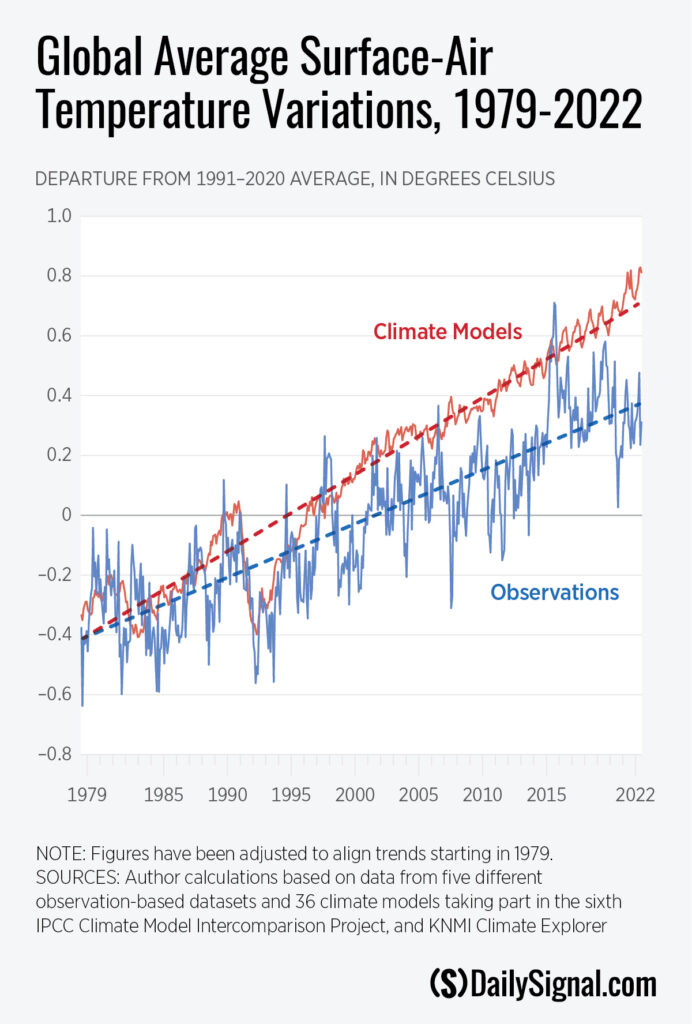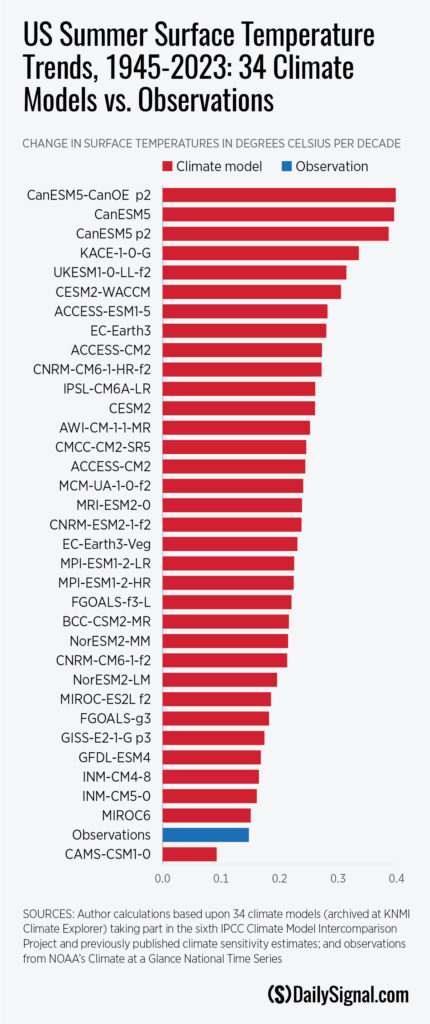Policies to reduce carbon dioxide emissions to minimize the effects of climate change should be guided by the best available science.
A new research paper from The Heritage Foundation provides compelling evidence—as indicated in the chart below—that warming in the past 50 years or so has been overestimated by most computer models when compared to temperature observations by thermometer.

The Heritage Foundation’s Backgrounder paper, written by the first author of this commentary, is titled “Global Warming: Observations vs. Climate Models.” (The Daily Signal is Heritage’s news outlet.)
A vocal minority of scientists often criticizes work such as this paper because their careers depend upon continued climate alarmism.
For example, NASA’s Gavin Schmidt, a mathematician by training who now oversees a subset of the climate models at the Goddard Institute for Space Studies, took issue with a few of the Heritage paper’s arguments, to which the author responded in detail here and here.
>>> Read the entire Heritage Backgrounder here.
So, how well do climate models predict the warming that actually has occurred?
Let’s look at trends in surface air temperature, averaged over the United States since 1945. Why 1945? For two reasons. First, CO2 emissions began to dramatically increase after World War II. Second, when one compares the future warming response in 33 computer models to a doubling of atmospheric CO2 above preindustrial levels (called “2x CO2“), 1945 is the starting year that produces the highest correlation between those warming trends and the eventual total amount of global-average warming in response to 2xCO2.
In other words, 1945 is the starting date when computer models’ past warming trends best predict future rates of global warming. The distribution of those past model trends is shown here:

Note that 33 out of 34 climate models produced warmer trends than those observed in the National Oceanic and Atmospheric Administration’s official reanalyzed thermometer data. The warming trend produced by the computer models (1945-2023) is 64% greater than the observed temperatures.
If we instead (as Schmidt suggested) restrict analysis to those computer models deemed by the United Nations’ Intergovernmental Panel on Climate Change to have the most likely response to 2X CO2 (2 to 5 degrees Celsius of net warming), then the model-average warming trend is still 54% greater than that observed, with 25 of 26 models producing more warming than was observed.
Why is this important? Well, for example, the United States does a congressionally mandated National Climate Assessment, now in its fifth iteration, in which a panel of climate activists interpret what the U.N. organization’s projections of climate change mean for U.S. residents.
A reading of the National Climate Assessment leaves one with the impression that every weather disaster, whether floods or hurricanes or wildfires or whatever, now can be blamed on climate change caused by humans.
No mention is made of the fact that almost all climate models exaggerate warming and associated effects in the U.S. In fact, the National Climate Assessment tends to lean toward the model projections showing the greatest projected effects in the U.S.
More fundamentally, regardless of one’s perception of climate change, carbon-based regulation in the U.S. will not alter global temperatures.
Heritage Foundation research has shown that using the Environmental Protection Agency’s preferred Model for the Assessment of Greenhouse Gas Induced Climate Change, the associated policies would reduce global temperatures by less than 0.2 degrees Celsius by 2100, even using alarmist assumptions about the extent of climate change.
At the same time, China will continue to pump CO2 into the atmosphere as it has done for years.
Policies such as congressional Democrats’ proposed Green New Deal would reduce household income by at least $165,000 over 20 years. Similar policies suggested by lawmakers also would have detrimental effects economically.
Computer models can be useful for understanding real-world phenomena. However, until scientists and lawmakers stop relying on demonstrably biased climate models, such models can’t be trusted to guide public policy.
Read the entire Heritage Backgrounder here.
Have an opinion about this article? To sound off, please email letters@DailySignal.com, and we’ll consider publishing your edited remarks in our regular “We Hear You” feature. Remember to include the URL or headline of the article plus your name and town and/or state.

























